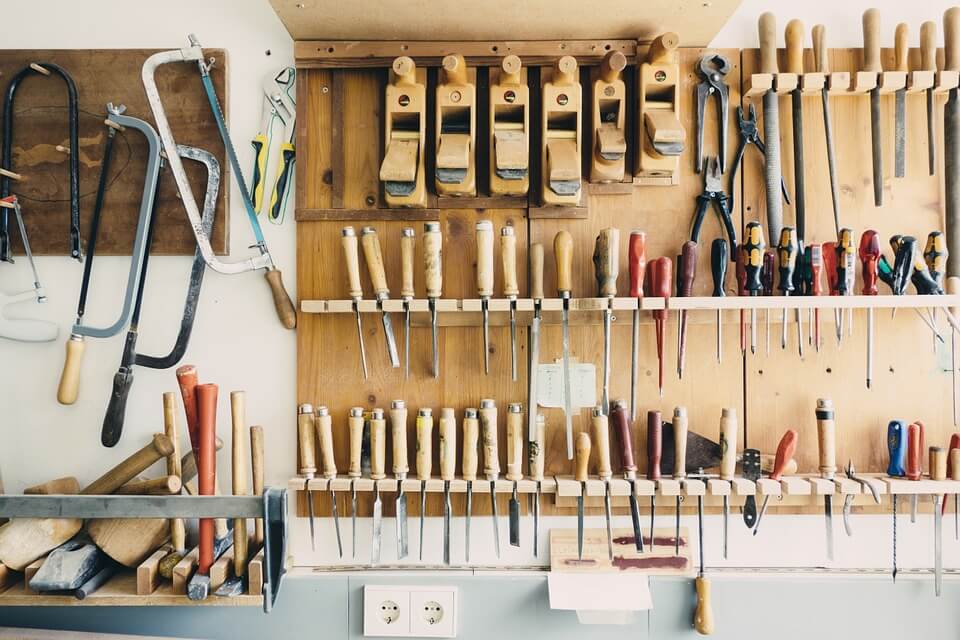
Whether beginning a workshop without any preparation or enhancing a current one, not many specialists will concoct a similar workshop tools list of things to get. Regularly the need is either a table saw, band saw, or outspread arm saw, trailed by the tool to spruce up wood, for example, a planer, machine, and drill press. The tool you will need will depend on a huge degree on the activities you wind up building regularly from that point on.
Many shop projects can be worked with only a major workshop, a drill press, and a decent router with accessories, alongside various hand devices. Need hand tools for carpentry to include a proper arrangement of chisels and a decent plane. Consider the workshop equipment recorded underneath as speculations. Assess your aim and pick the workshop tools that best suits your necessities. There is no specific reason to get them simultaneously; however, as your abilities improve and your tasks develop more intricate, add the tools that will give you the correct outcomes: straight cuts, strong joints, and square corners.
The equipment in your workshop will rely upon your areas of specialty, interests, and level of involvement. Following is the list of some of the essential hand- tools that should be found in most basic workshops.
- Measuring Tools
Measuring tapes available in an assortment of lengths, for example, 12, 18, 25, or 33 feet. Recall that the more extended the tape, the heavier it will be. A 33-foot tape is a decent option for a genuine builder or skilled worker. Some measuring tapes are set apart in eighths of an inch, which disentangles estimation and count of precise measurements.
Special measuring tapes are known as long tapes available in lengths of 100 feet or more and are useful when estimating distances for building structures, landscaping, and so forth. The tape is housed on a reel that wrenches to pull the tape in.
A speed square is utilized for estimating and checking points in construction. It is built with a lipped straight edge making it simple to check 45-degree and 90-degree points, and it has assignments for a portion of the more usually utilized estimations and points. A speed square is an outright need for serious structure and construction.
Levels available in an assortment of sizes, lengths, and styles – including high-tech levels that utilize a laser beam. The basic level utilizes a straight edge and fluid-filled compartments that contain an air pocket. The air pocket is arranged between markings on the fluid-filled cylinders to decide when a surface or line is level.
- Power Drill
A decent Power drill is probably the best speculation most DIYers can make. It can drill holes and drive screws and fasteners a lot quicker than should be possible with hand devices. If you figure you will require the tools rarely, you might need to purchase a reasonably estimated corded drill. In any case, almost everybody will value claiming a cordless drill. Fair 12-or 14.4-volt cordless drills can be purchased for $50 to $90. Search for a 3/8-inch model that either revives rapidly or accompanies two batteries.
- Air Compressor
In this time of air-powered nailers, drills, sanders, sway wrenches, grinders, spray guns, saws, washers, and other pneumatic equipment, the compressor has become a virtual need. The compressor comprises of a motorized pump; a tank for storing the compressed air; an on/off control (lead representative) that advises the pump when to begin and stop to keep the pressure inside preset cutoff points; and a controller to control the weight at which the air gets away from the tank to fill the requirements of the tools being utilized. There’s a metal casing on which all the parts are mounted, generally with a conveying handle and sometimes wheels.
- Stud Finder
Battery-operated Zircon stud locater models have been demonstrated to be sensibly dependable with drywall walls and roofs. On thicker mortar walls, you can frequently discover success utilizing the metal-detecting setting on the stud locater, which can recognize the nails used to tie down wood lath to studs.
- Cordless Drills
Cordless drills are one of the great and versatile tools in the workshop building. Besides being utilized for boring into an assortment of materials, they can be fitted with a screwdriver connection to make driving screws into the wood a snap. Since they are cordless, they won’t frustrate your portability. Corded drills have the burden of the string restricting your movement; however, they are accessible in torque and strengths more noteworthy than their cordless counterparts.
- Miter Saw
This flexible and precise tool has become a fixture in the workshop and at the worksite as of late. Likewise called a ” chop box,” the miter saw comprises an incredible circular saw mounted on an arm that hinges at the device’s back. When the blade is brought down in a chopping motion, it slices through the workpiece, going through a space in the base. The motor and sharp blade can be rotated concerning the base for miter cuts. Another change makes it conceivable to tilt the blade and consider compound miter cuts, helpful for work like cutting crown moldings, which are set at a pitched point, and that must likewise pivot corners.
- Screwdrivers
Each workshop – or toolbox, so far as that is concerned – requires both Phillips head and level head (slotted) screwdrivers. Every one of these sorts arrives in an assortment of sizes. There are different kinds of screwdrivers, including Hex and Torx heads – for more specific uses. Phillips and flat-head heads are the most widely recognized. A nut driver works much the same as a screwdriver yet has an attachment toward fixing and eliminating nuts, similarly as with a socket wrench.
- Hammer
A curved claw hammer can drive and eliminate nails. Some 20-ounce form with a smooth face and straight (instead of twisted) hook. Some will incline toward a lighter sled, yet we don’t prescribe to go under 16 ounces. Steel and fiberglass handles are ideal.
In our model workshop, the most ordinarily utilized tools – mallets, hammers, levels, screwdrivers, and so on – were held tight a pegboard over the workstation. A separate pegboard is home to measuring, marking, and cutting instruments, just as pliers and wrenches.
Be Heard at Go Home NY
Be heard! Leave your apartment, condo, and coop building reviews at Go Home NY! Know a building's managers are awful? Have the inside line on a perfect building? Anything in between? Express your voice and be heard. Leave a review at Go Home NY.


